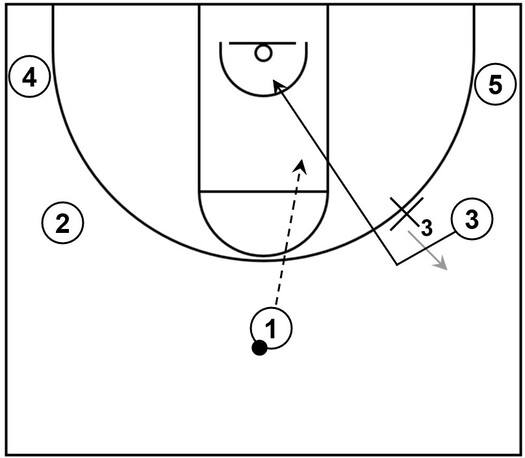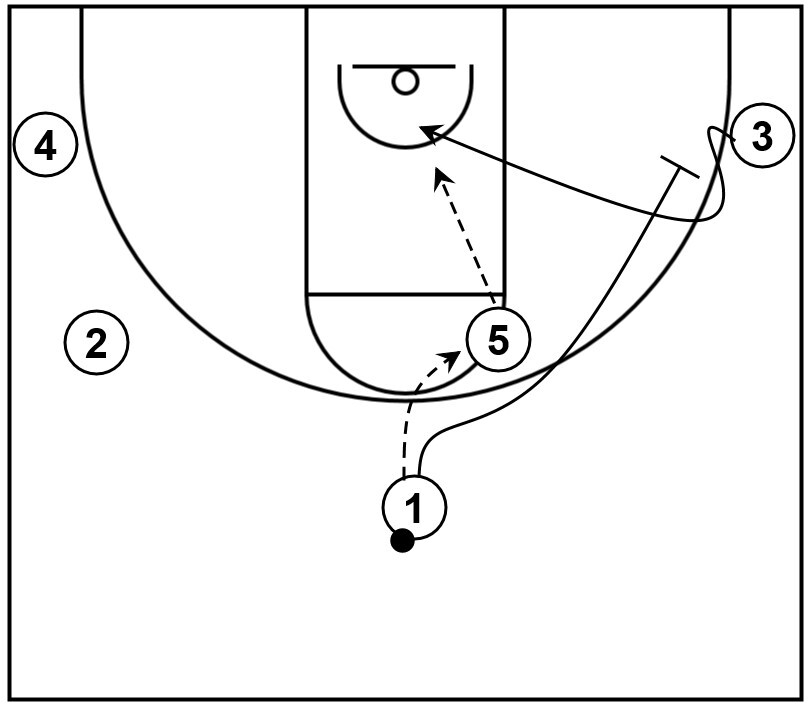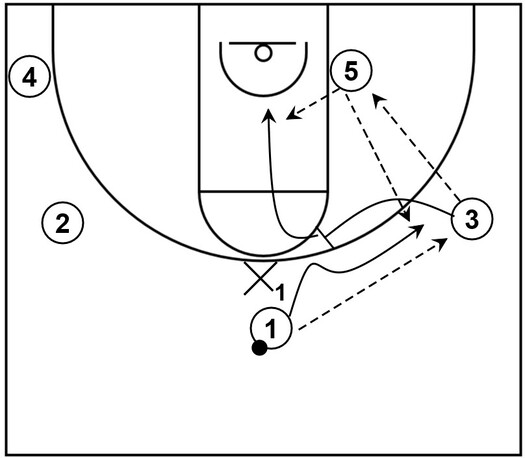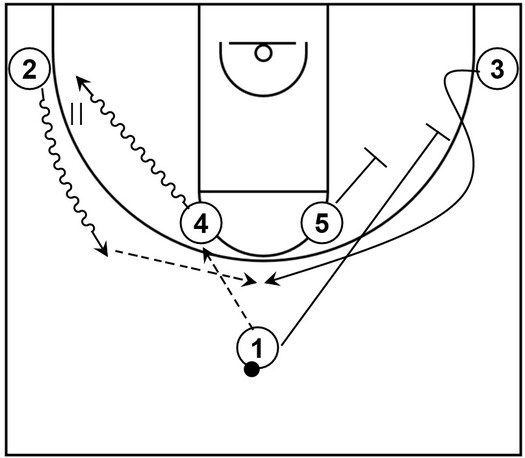Basic information about the small forward
General definition
The small forward is one of the five common basketball positions, typically capable of doing a little bit of everything as it relates to scoring, rebounding, playmaking, and defending near the basket or around the perimeter areas of the court.
Number format and abbreviation
In terms of its number format, the small forward is usually indicated by the number 3. The small forward is also sometimes referred to as the 3-man as well.
The typical abbreviation for the small forward position is generally known as SF.
Examples of small forward offensive actions
This section includes simple examples of offensive actions that could be utilized by the small forward during a basketball game, which could possibly result in scoring opportunities around perimeter areas or near the rim.
In addition, each of the offensive and/or defensive players on any diagrams below are generally represented by the standard basketball positions, unless otherwise noted.
In essence, 1 and X1 are the offensive and defensive point guards, respectively.
2 and X2 are the offensive and defensive shooting guards, respectively.
3 and X3 are the offensive and defensive small forwards, respectively.
4 and X4 are the offensive and defensive power forwards, respectively.
5 and X5 represent the offensive and defensive center positions, respectively.
Backdoor cut

This is an example of a small forward utilizing a backdoor cut to get open near the basket.
For the initial setup: 1 is at the top with possession of the ball, represented by the black dot; 2 and 3 occupy the left side and right side wing areas respectively; 4 and 5 fill the left side and right side corner areas respectively.
Also, as a side note, this particular setup is a 5 out alignment as five offensive players are outside of the lane away from the basket and beyond the three-point line.
Continuing on, let’s say that the offensive team wants to initiate their basketball offense by making an entry pass to the small forward (3) who is occupying the right side wing area.
However, this potential passing action is being taken away by the defender, indicated as X3, particularly with denial defense, represented by the solid gray arrow.
In essence, X3 is placing a part of their body, more specifically, their hand and leg in between the passing lane of 1 and 3. Doing that prevents 3 from easily catching the ball via the pass from 1.
What’s more, if 1 attempted to throw that pass, then X3 could deflect or possibly intercept the ball, which could result in a steal for the defense and subsequent turnover for the offensive team.
So, to counter that, 3 can execute a backdoor cut by taking a quick step towards the ball and then immediately cutting to the basket.
Next, 1 passes the ball, represented by the dotted arrow, with 3 as the recipient. After that, 3 scores via a layup at the rim.
Curl cut

This is an example of a small forward executing a curl cut to get open near the basket.
This action is also reminiscent of the Point Series of Princeton Offense, particularly the Point Over subset.
In terms of the initial setup: 1 is at the top in possession of the ball; 2 fills the left side wing area; 3 and 4 fill the right side corner and left side corners respectively; 5 occupies the right side high post elbow area.
To start, 5 receives the ball from 1 and afterwards, 1 cuts over 5 to set a wide pin down screen.
Next, 3 executes a curl cut by way of that screen and moves toward the basket. From there, 3 receives the ball from 5 and scores at the rim via a layup.
Split cut

This is another example of a small forward carrying out offensive action via a split cut, which could lead to a scoring opportunity.
In terms of the initial setup: 1 is at the top in possession of the basketball; 2 and 3 fill the left side and right side wing areas respectively; 4 occupies the left side corner; 5 takes up space near the right side low post area.
To start, 3 receives the ball from 1 and quickly makes the post entry pass to 5.
Next, 3 executes a split cut followed by an away screen near the right side high post elbow area, which is set on X1, the defender who is guarding against 1.
Following that, 1 uses that screen and cuts to the previously occupied right side wing area while 3 slips to the basket.
From there, 3 could receive the ball from 5 and score via a layup. Alternatively, 1 could receive the ball instead and take the three-point shot if that is open.
Stagger screen

This is an example of offensive action that shows a small forward utilizing a stagger screen, ultimately to get open beyond the three-point line.
In reference to the initial setup: 1 is at the top in possession of the ball; 2 and 3 occupy the left and right side corners respectively; 4 and 5 fill the left and right side high post elbow areas respectively. This particular setup is also derived from the Horns set.
To begin, 4 receives the ball from 1 and afterwards, 1 and 5 cut towards 3 to set a stagger screen on the weak side.
At the same time on the strong side, 2 and 4 complete a dribble handoff, shown via the double pipe symbol on the diagram.
Next, as 2 begins to dribble back towards the wing area, 3 cuts to the top via the stagger screen set by 1 and 5.
From there, 3 receives the ball from 2 and can take the three-point shot if that is open.
General summarized traits of a small forward
Scoring
The small forward is typically a capable scorer with the ability to generate points via several methods.
Attack the rim
The small forward could attack the rim while in possession of the basketball, primarily by way of a swift first step or via dribbling moves against an opponent.
Afterwards, the small forward could score around the basket with a layup, dunk, or floater before the help defense is able to potentially hinder or completely prevent the opportunity to score.
Utilize on-ball screen
The small forward could utilize the on-ball screen to establish dribble penetration into the gaps of the overall defense, particularly adjacent to the nail area or the lane area.
Following that, the small forward could score via a mid-range jump shot, or simply by way of a close-range shot around the rim.
Utilize off-ball screens
The small forward could utilize several types of off-ball screens to get open near the perimeter, or possibly near the basket.
From there, the small forward could receive the ball and then score points via the execution of layups, dunks, floaters, or high quality open jump shots that are not heavily contested by potential defenders.
Cut from the weak side
The small forward could cut to the basket, particularly from the weak side perimeter areas of the court, receive the ball from another offensive player, and then quickly score at the rim before the defense is able to properly react.
Playmaking
The small forward could be a sufficient playmaker during offensive execution, which could also result in at least a handful of assists.
As an example of this potential playmaking ability, let’s say that the small forward utilizes one or more dribbling moves against an on-ball defender to ultimately attack the basket and/or get into the lane area.
As a result of that happening, one or more off-ball defenders would be influenced to collapse into the lane to stop further dribble penetration and/or to prevent uncontested layups at the rim.
When that occurs, another offensive player could receive the ball via a kick pass or drift pass from the small forward.
Afterwards, that same offensive player could take and make an open jump shot, which would increase that same player’s point total and give the small forward an assist.
As another brief example of playmaking, the small forward might be able to execute a lob pass to a teammate such as a power forward or center near the basket after dribbling into the lane. This, in turn, could result in an easy layup or dunk, primarily via alley-oop action.
Defense
The small forward could be an effective defender in terms of containing the ball and/or executing defensive closeouts near the perimeter areas of the court.
Furthermore, if the small forward possesses enough speed and quickness, then perimeter-oriented defensive switching could become very useful.
In other words, faster small forwards with above average lateral quickness could potentially switch onto a point guard or shooting guard, particularly when the offensive team executes different types of basketball screens.
In addition to that, the small forward might also be able to efficiently cover the low post areas around the basket.
Basically, if the small forward is strong and athletic with long arms, then that would give them the opportunity to guard against offensive low post players.
This would generally occur by way of defensive switching or possibly during a small ball sequence that would essentially feature the small forward in the role of an undersized power forward.
Rebounding
The small forward is generally an adequate rebounder, especially on the defensive side of the ball.
Essentially, the small forward can initially box out their respective assignment during man to man defense or the nearest offensive player in a zone defense coverage.
Following that, the small forward could utilize their height and arm length to grab an ample amount of defensive rebounds.
However, it should also be noted that the small forward can occasionally collect a decent amount of offensive rebounds such as via tip-in action.
Additional insights about the small forward
General difference between small forward and point guard or shooting guard
In terms of the difference between a small forward and a point guard or shooting guard, the small forward is usually taller and/or stronger.
Furthermore, the small forward is also a better rebounder in general than the point guard or shooting guard, primarily due to height advantage as well as their typically longer wingspan.
Conversely, the small forward usually does not possess the same level of quickness and/or footspeed as the point guard or shooting guard.
Moreover, the dribbling skills of the small forward are generally acceptable for their respective position.
However, at the same time, those dribbling skills may not be as adept when compared to those of the point guard or shooting guard.
In addition to that, the small forward is typically more than capable of generating at least a moderate amount of assists but usually not as much as the point guard, who is commonly the team’s play initiator and primary ball handler.
General difference between small forward and power forward or center
In relation to the difference between a small forward and a power forward or center, the small forward is usually much faster and/or quicker but generally not as tall and/or as strong.
In addition to that, the small forward could possibly have a more accurate jump shot from mid-range or three-point range in terms of field goal percentage than the power forward or center.
Nevertheless, this is not always the case. Basically, a special type of power forward, commonly known as the stretch four, could potentially shoot the basketball at the same level or even a higher percentage than the small forward, especially from three-point range.
Moreover, it is also quite possible that at least a handful of centers could possess a perimeter shooting ability that is just as good (or perhaps better in a few cases) than the small forward.
For example, notable NBA centers with adept three-point shooting skills include players such as Nikola Jokić, Myles Turner, and Joel Embiid, to name a few.
Furthermore, the small forward typically operates near the perimeter areas of the court, especially the wings, as opposed to remaining consistently near the low post areas, which are generally utilized more by the power forward and the center positions.
However, it should be stated that it is usually possible for a player in the position of a small forward to score around the basket via a series of low post moves, if and when it is necessary for that player to do so.
Additionally, the small forward generally does not collect as many rebounds, especially offensive rebounds, as the power forward and/or center positions.
This is commonly a result of the small forward being near the perimeter areas of the court, especially during offensive action, more often than around the basket as mentioned previously.
What’s more, the small forward is normally not as tall or long as the power forward/center, which could also contribute to less overall rebounds comparatively.